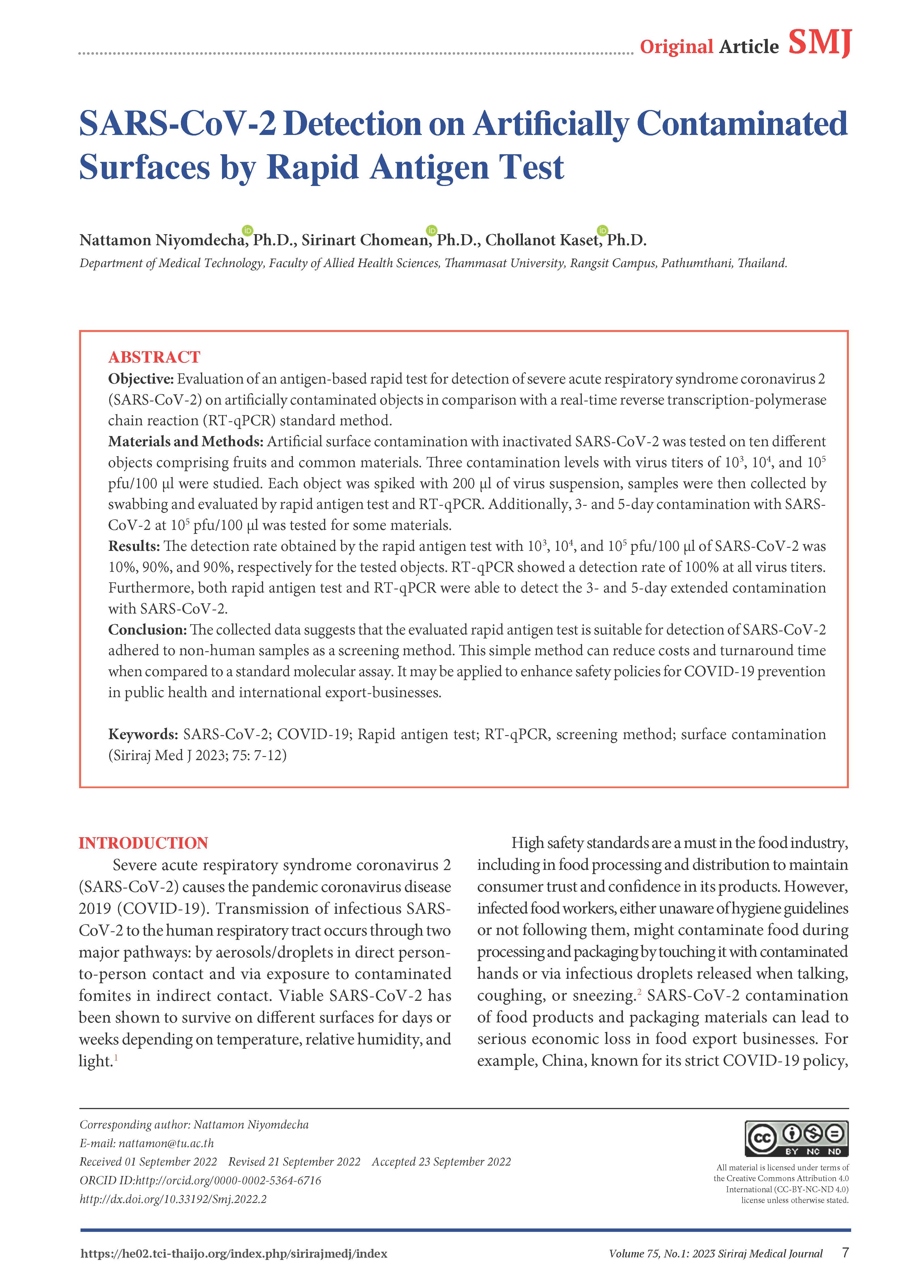SARS-CoV-2 Detection on Artificially Contaminated Surfaces by Rapid Antigen Test
DOI:
https://doi.org/10.33192/smj.v75i1.260524Keywords:
SARS-CoV-2, COVID-19, Rapid antigen test, RT-qPCR, screening method, surface contaminationAbstract
Objective: Evaluation of an antigen-based rapid test for detection of severe acute respiratory syndrome coronavirus 2 (SARS-CoV-2) on artificially contaminated objects in comparison with a real-time reverse transcription-polymerase chain reaction (RT-qPCR) standard method.
Materials and Methods: Artificial surface contamination with inactivated SARS-CoV-2 was tested on ten different objects comprising fruits and common materials. Three contamination levels with virus titers of 103, 104, and 105 pfu/100 μl were studied. Each object was spiked with 200 μl of virus suspension, samples were then collected by swabbing and evaluated by rapid antigen test and RT-qPCR. Additionally, 3- and 5-day contamination with SARSCoV‑2 at 105 pfu/100 μl was tested for some materials.
Results: The detection rate obtained by the rapid antigen test with 103, 104, and 105 pfu/100 μl of SARS-CoV-2 was 10%, 90%, and 90%, respectively for the tested objects. RT‑qPCR showed a detection rate of 100% at all virus titers. Furthermore, both rapid antigen test and RT-qPCR were able to detect the 3- and 5-day extended contamination with SARS-CoV-2.
Conclusion: The collected data suggests that the evaluated rapid antigen test is suitable for detection of SARS-CoV-2 adhered to non-human samples as a screening method. This simple method can reduce costs and turnaround time when compared to a standard molecular assay. It may be applied to enhance safety policies for COVID-19 prevention in public health and international export-businesses.
References
Aboubakr HA, Sharafeldin TA, Goyal SM. Stability of SARSCoV-2 and other coronaviruses in the environment and on common touch surfaces and the influence of climatic conditions: A review. Tranbound Emerg Dis. 2021;68(2):296-312.
Shukla S, Cho H, Kwon OJ, Chung SH, Kim M. Prevalence and evaluation strategies for viral contamination in food products: Risk to human health—A review. Crit Rev Food Sci Nutr. 2018;58(3):405-19.
Taylor M. China warns Thailand to fix durian Covid-19 problem or face export ban [Internet]. 2022 Apr [cited 2022 Sep 25].
Available from: https://thethaiger.com/news/national/chinawarns-thailand-to-fix-durian-covid-19-problem-or-face-exportban
Benkeblia N. In the landscape of SARS-CoV-2 and fresh fruits and vegetables: The fake and hidden transmission risks. J Food Saf. 2021;41(4):e12898.
Fernandez-Montero A, Argemi J, Rodríguez JA, Ariño AH, Moreno-Galarraga L. Validation of a rapid antigen test as a screening tool for SARS-CoV-2 infection in asymptomatic populations. Sensitivity, specificity and predictive values. EClinicalMedicine. 2021;37:100954.
ProGnosis Biotech [homepage on the Internet]. Rapid Test Surface Ag 2019-nCoV [cited 2022 Sep 20]. Available from:https://www.prognosis-biotech.com/product/rapid-test-surface-ag-2019-ncov/
Loveday EK, Hain KS, Kochetkova I, Hedges JF, Robison A, Snyder DT, et al. Effect of inactivation methods on SARSCoV-2 virion protein and structure. Viruses. 2021; 13(4):562.
Dehbandi R, Zazouli MA. Stability of SARS-CoV-2 in different environmental conditions. Lancet Microbe. 2020;1(4):e145.
van Doremalen N, Bushmaker T, Morris DH, Holbrook MG, Gamble A, Williamson BN, et al. Aerosol and surface stability of SARS-CoV-2 as compared with SARS-CoV-1. N Engl J Med. 2020;382(16):1564-7.
Corpet DE. Why does SARS-CoV-2 survive longer on plastic than on paper? Med Hypotheses. 2021;146:110429.
Bean B, Moore BM, Sterner B, Peterson LR, Gerding DN, Balfour HH Jr. Survival of influenza viruses on environmental surfaces. J Infect Dis. 1982;146(1):47-51.
Casanova LM, Jeon S, Rutala WA, Weber DJ, Sobsey MD. Effects of air temperature and relative humidity on coronavirus survival on surfaces. Appl Environ Microbiol. 2010;76(9):2712-7.

Published
How to Cite
Issue
Section
License

This work is licensed under a Creative Commons Attribution-NonCommercial-NoDerivatives 4.0 International License.
Authors who publish with this journal agree to the following conditions:
Copyright Transfer
In submitting a manuscript, the authors acknowledge that the work will become the copyrighted property of Siriraj Medical Journal upon publication.
License
Articles are licensed under a Creative Commons Attribution-NonCommercial-NoDerivatives 4.0 International License (CC BY-NC-ND 4.0). This license allows for the sharing of the work for non-commercial purposes with proper attribution to the authors and the journal. However, it does not permit modifications or the creation of derivative works.
Sharing and Access
Authors are encouraged to share their article on their personal or institutional websites and through other non-commercial platforms. Doing so can increase readership and citations.














